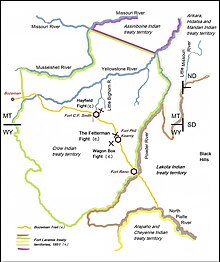TraitÃĐ de Fort Laramie (1868)
|
Read other articles:

1967 film by Gordon Douglas Tony RomeOriginal one-sheet posterDirected byGordon DouglasScreenplay byRichard L. BreenBased onMiami Mayhem1960 novelby Marvin AlbertProduced byAaron RosenbergStarringFrank SinatraJill St. JohnRichard ConteSue LyonCinematographyJoseph F. BirocEdited byRobert L. SimpsonMusic byLee Hazlewood (title song)Billy MayColor processDeLuxe ColorProductioncompanyArcola PicturesDistributed byTwentieth Century Fox Film CorporationRelease date November 10, 1967 (196…

Clause abolishing the permanent army Memorial plaque of the Article in the National Museum The Article 12 of the Constitution of Costa Rica abolishes Costa Rica's army as a permanent institution, making Costa Rica one of the first countries in the world to do so as the current Constitution was enacted in 1949.[1] Costa Rica is one of the few countries without armed forces and, alongside Panama, one of the few that is not a microstate. However, like Panama, Costa Rica does have limited mi…

Small harbour on North coast of South Georgia, South Atlantic Location of Prince Olav Harbour Prince Olav Harbour is a small harbour in the south west portion of Cook Bay, entered between Point Abrahamsen and Sheep Point, along the north coast of South Georgia.[1] Background Throughout the 19th century, South Georgia was a sealers' base and, in the following century, became a whalers' base. Prince Olav Harbour is the site of one of the seven main whaling bases established on South Georgi…

Berikut adalah artikel tentang daftar Kepala Daerah dan Wakil Kepala Daerah di 38 kabupaten/kota di Jawa Timur yang saat ini masih menjabat. Kabupaten/Kota Foto Bupati/Wali Kota Bupati/Wali Kota Foto Wakil Bupati/Wali Kota Wakil Bupati/Wali Kota Mulai Menjabat Selesai Menjabat(Direncanakan) Ref KabupatenBangkalanDaftar Bupati/Wakil Bupati Arief Moelia Edie(Penjabat) 24 September 2023 Menunggu pelantikan bupati dan wakil bupati terpilih hasil pemilihan umum Bupati Bangkalan 2024 [1] Kabup…

æĪæĄįŪåščĻįŦ čæēĄæå åæŧįŧå Ļæå åŪđčĶįđã (2019åđī3æ21æĨ)čŊ·ččæĐå åščĻïžæļ æ°æĶčŋ°æĄįŪææééŧãčŊ·åĻæĄįŪįčŪĻčŪšéĄĩčŪĻčŪšæĪéŪéĒã åčĻå æŊåĶįļ―įĩąåčĐå įļ―įĩąæįūäŧŧŌаŅŅО-ÐÐūОаŅŅ ÐÐĩОÐĩÐŧŌąÐŧŅ ÐĒÐūŌаÐĩÐēåĄįå§čĨéĐŽå°įđ·æåĄčķåĪŦčŠ2019åđī3æ20æĨåĻäŧŧäŧŧæ7åđīéĶäŧŧåŠå°čäļđ·įšģæå°å·īčķåĪŦčŪūįŦ1990åđī4æ24æĨïžåčĐå čįķåįĪūæäļŧįūĐå ąååįļ―įĩąïž åčĻå æŊåĶ åčĻå æŊåĶæŋåščæ…

An aquarium with a fish feeder Aquarium fish feeders are electric or electronic devices that are designed to feed aquarium fish at regular intervals. They are often used to feed fish when the aquarist is on vacation or is too busy to maintain a regular feeding schedule.[1] Design Fish feeders are usually clamped to the wall of the tank just over the water. Most designs consist of a hopper which is loaded with a variety of dry food, a timer which rotates the hopper at regular intervals (d…

ØŽŲ ŲŲØąŲØĐ Ų ŲØŊŲŲŲا اŲاØīØŠØąØ§ŲŲØĐ ÐĄÐūŅÐļŅаÐŧÐļŅŅÐļŅКа Ð ÐĩÐŋŅÐąÐŧÐļКа ÐаКÐĩÐīÐūÐ―ÐļŅа ØŽŲ ŲŲØąŲØĐ Ų ŲŲŲØĐ ŲŲŲØšŲØģŲاŲŲا 1944 â 1991 ØŽŲ ŲŲØąŲØĐ Ų ŲØŊŲŲŲا اŲاØīØŠØąØ§ŲŲØĐØđŲŲ ØŽŲ ŲŲØąŲØĐ Ų ŲØŊŲŲŲا اŲاØīØŠØąØ§ŲŲØĐØīØđØ§Øą Ų ŲØŊŲŲŲا ØŊاØŪŲ ŲŲØšŲØģŲاŲŲا ØđاØĩŲ ØĐ ØģŲŲØĻŲŲ ŲØļاŲ اŲØŲŲ ØŽŲ ŲŲØąŲØĐ Ø§ØīØŠØąØ§ŲŲØĐ Ø§ŲŲØšØĐ Ø§ŲØąØģŲ ŲØĐ Ø§ŲØĩØąØĻŲØĐ Ø§ŲŲØąŲا؊ŲØĐØ &…

High military command of the Russian Empire, Soviet Union and Ukraine This article needs additional citations for verification. Please help improve this article by adding citations to reliable sources. Unsourced material may be challenged and removed.Find sources: Stavka â news · newspapers · books · scholar · JSTOR (January 2019) (Learn how and when to remove this message) The Stavka (Russian and Ukrainian:[1] ÐĄŅаÐēКа, Belarusian: ÐĄŅаŅК…

Yvonne De CarloDe Carlo pada 1951LahirMargaret Yvonne Middleton(1922-09-01)1 September 1922West Point Grey, Vancouver, British Columbia, KanadaMeninggal8 Januari 2007(2007-01-08) (umur 84)Woodland Hills, Los Angeles, California, Amerika SerikatSebab meninggalGagal jantung[1]MakamKremasiPekerjaanAktris, penyanyi, penariTahun aktif1941â1995Suami/istriRobert Drew Morgan (m. 1955–1973)AnakBruce Ross Morgan Michael …

For the neighborhood of St. Louis, Missouri, see Hamilton Heights, St. Louis. Neighborhood of Manhattan in New York CityHamilton HeightsNeighborhood of ManhattanSt. Mark's United Methodist ChurchLocation in New York CityCoordinates: 40°49âē30âģN 73°56âē56âģW / 40.825°N 73.949°W / 40.825; -73.949Country United StatesState New YorkCityNew York CityBoroughManhattanCommunity DistrictManhattan 9[1]Area[2] âĒ Total1.08 km2 (0.41…

Not to be confused with Up & Down â The Party Album, a 1998 album by the same artist. 1999 studio album (reissue) by VengaboysThe Party AlbumStudio album (reissue) by VengaboysReleased4 June 1999GenreEurodanceLabelBreakin', Jive, Positiva, Groovilicious, Avex TraxProducerVengaboysVengaboys chronology Greatest Hits! Part 1(1998) The Party Album(1999) The Remix Album(1999) Singles from The Party Album Up and DownReleased: February 1998 We Like to Party (The Vengabus)Released:…

Type of court in many countries Circuit courts are court systems in several common law jurisdictions.[1] It may refer to: Courts that literally sit 'on circuit', i.e., judges move around a region or country to different towns or cities where they will hear cases; Courts that sit within a judicial circuit, i.e., an administrative division of a country's judiciary; or A higher-level trial court, e.g., for felony or indictment offences. History Origin in England The term circuit court is de…

ŲØ°Ų اŲŲ ŲاŲØĐ ØđŲ ØĻØĩŲ ØŪØķØąŲا؊. ŲŲŲ Ų ØŪØķØąŲØ§ØŠØ Ø·Ø§ŲØđ ØĻØĩŲ ØĢØŪØķØą. ØŽØēØĄ Ų Ų ØģŲØģŲØĐ Ų ŲاŲا؊ ØŲŲاŲŲ Ø·ØĻØŪ اŲØđØąØĻŲ ØØģØĻ اŲØĻŲØŊ اŲØŽØēŲØąØĐ Ø§ŲØđØąØĻŲØĐ Ø§ŲØĻØØąŲŲ اŲØĨŲ Ø§ØąØ§ØŠ اŲŲŲŲØŠ ØģŲØ·ŲØĐ ØđŲ اŲ ŲØ·Øą اŲØģØđŲØŊŲØĐ Ø§ŲŲŲ Ų اŲŲ ØšØąØĻ اŲŲØĻŲØą اŲØŽØēاØĶØą ŲŲØĻŲا Ų ŲØąŲ؊اŲŲا اŲŲ ØšØąØĻ ØŠŲŲØģ اŲØīاŲ اŲØđØąØ§Ų اŲØĢØąØŊŲ ŲØĻŲاŲ ŲŲØģØ·ŲŲ ØģŲØąŲا ŲŲØą ا…

Peta menunjukkan lokasi Pantabangan Data sensus penduduk di Pantabangan Tahun Populasi Persentase 199522.183â200023.8681.58%200725.5200.93% Pantabangan adalah munisipalitas yang terletak di provinsi Nueva Ecija, Filipina. Pada tahun 2010, munisipalitas ini memiliki populasi sebesar 25.520 jiwa dan 5.465 rumah tangga. Pembagian wilayah Secara administratif Pantabangan terbagi menjadi 14 barangay, yaitu: Cadaclan Cambitala Conversion Ganduz Liberty Malbang Marikit Napon-Napon Poblacion East Pobl…

2009 single by Blazin' SquadLet's Start AgainSingle by Blazin' Squadfrom the album Greatest Hits Released15 June 2009Recorded2008GenreR&BLabelNaughty Boy RecordsBlazin' Squad singles chronology All Night Long (2006) Let's Start Again (2009) Let's Start Again is a song by the then five-piece hip-hop group Blazin' Squad, released as a single on 15 June 2009. Background In 2009, Strider, Flava, Kenzie, Krazy and Rocky B announced that they would be reuniting as a five-piece version of Blazin' S…

American surf pop band Best CoastBest Coast performing in 2011Background informationOriginLos Angeles, USGenres Indie pop surf indie rock alternative rock power pop Years active2009â2023 (hiatus)LabelsJewel CityMexican SummerWichitaPost Present MediumGroup TightenerArt Fag RecordingsBlack IrisBlackest RainbowKobalt[1]HarvestPast members Bethany Cosentino Bobb Bruno Websitebestcoast.net Best Coast is an American rock duo formed in Los Angeles, California in 2009, currently on hiatus. Th…

Island and region of Japan This article is about the location in Japan. For the Chinese place with the cognate name Jiuzhou, see Nine Provinces. You can help expand this article with text translated from the corresponding article in Japanese. Click [show] for important translation instructions. Machine translation, like DeepL or Google Translate, is a useful starting point for translations, but translators must revise errors as necessary and confirm that the translation is accurate, rather than …

Mountain in New Hampshire, United States Mount SunapeeView from Lake SunapeeHighest pointElevation2,726 ft (831 m)Prominence1,466 ft (447 m)Coordinates43°18âē49âģN 72°4âē27âģW / 43.31361°N 72.07417°W / 43.31361; -72.07417GeographyLocationNewbury / Goshen, New Hampshire, U.S.Topo mapUSGS Newport QuadrangleClimbingEasiest routeAndrew Brook Trail Mount Sunapee (or Sunapee Mountain on federal maps) is a 5-mile-long (8.0 km) mountain ridge…

Peta California, sekitar tahun 1650 Pulau California adalah sebutan orang Eropa pada abad ke-16 yang mengira bahwa California bukan bagian dari benua Amerika dan merupakan satu pulau besar yang terpisah oleh teluk California. Kesalahan ini dicetak dalam peta-peta dari abad ke-17 dan 18. Selain itu ada juga legenda yang mengatakan bahwa California adalah taman Eden atau Atlantis. Istilah ini pertama kali ditemukan dalam novel tahun 1510 berjudul Las Sergas de EsplandiÃĄn oleh Garci RodrÃguez de …

South African diplomat and poet (1960â2020) Her ExcellencyZindzi Mandela-HlongwaneAmbassador to the Kingdom of Denmarkfrom South AfricaIn office2015 â 13 July 2020PresidentJacob ZumaCyril RamaphosaStand-inFirst Lady of South AfricaIn office1996â1998Serving with Zenani Mandela-Dlamini(sister)PresidentNelson Mandela(father)Succeeded byGraça Machel(step-mother) Personal detailsBornZindziswa Nobutho Mandela(1960-12-23)23 December 1960Soweto, Union of South AfricaDied13 July 2…


